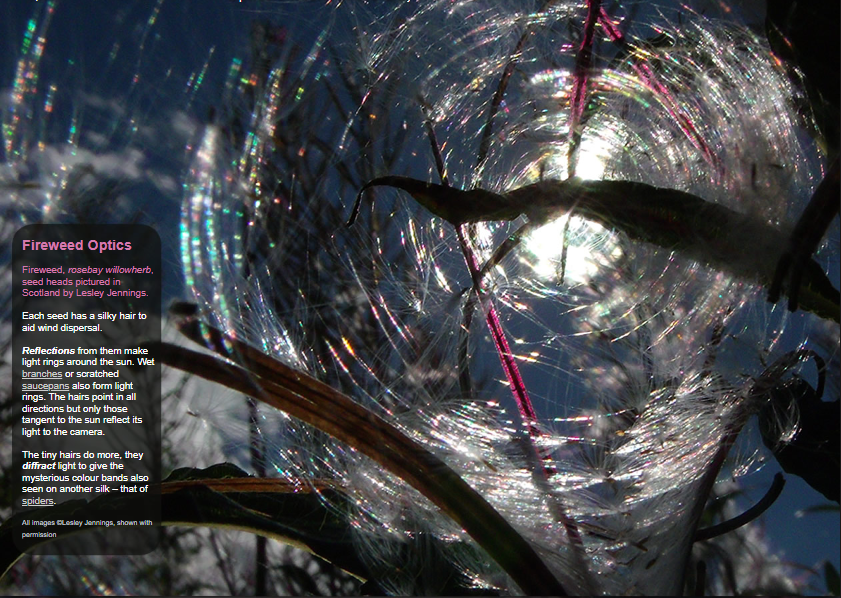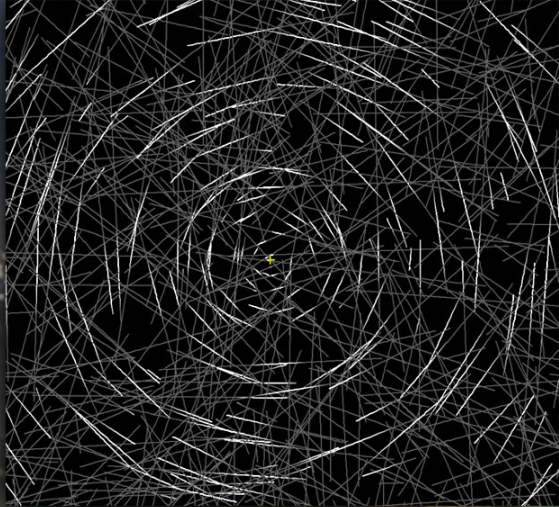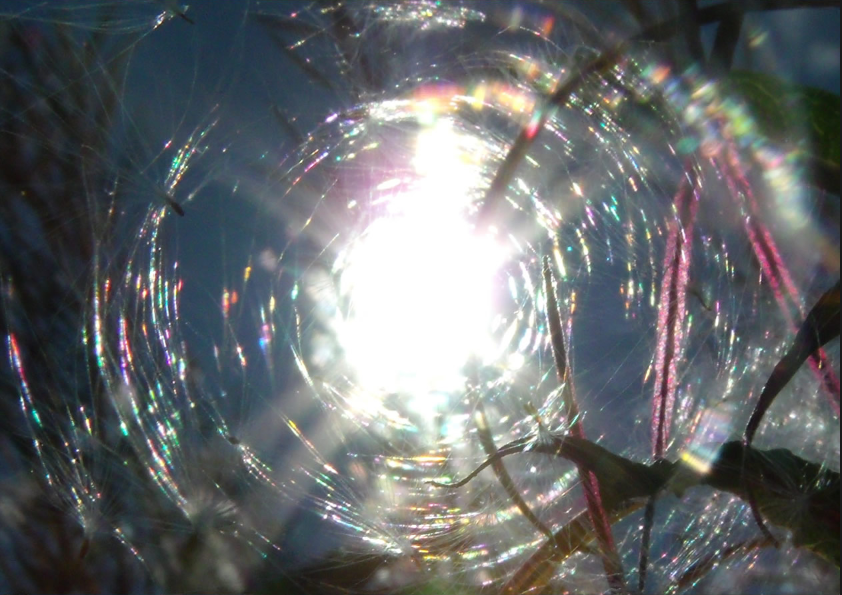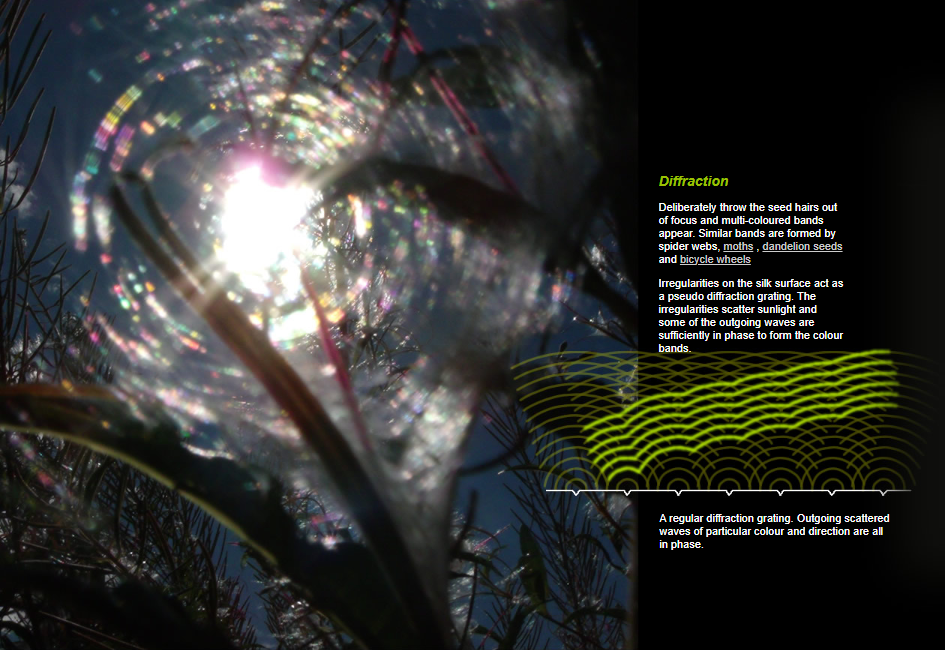Fireweed Reflection & Diffraction - OPOD
Fireweed Reflection & Diffraction: Unveiling the Mysterious Optics
Have you ever noticed mesmerizing light rings encircling the sun? These captivating phenomena can be observed when the light interacts with certain objects, such as fireweed seed heads, wet branches, or even scratched saucepans. In this article, we will delve into the intriguing world of fireweed reflection and diffraction, uncovering the science behind these enchanting optical effects.
The Dance of Light Rings
When sunlight encounters fireweed seed heads, a remarkable play of reflection unfolds. Each seed is adorned with delicate silky hairs that aid in wind dispersal. These hairs not only create reflections but also generate ethereal light rings around the sun. While the hairs point in various directions, only those tangent to the sun reflect its light back towards the camera. This phenomenon accounts for the luminous circles that grace our skies.
The Intricacies of Reflection
To better understand the formation of light rings, we can turn to computer simulations. By drawing lines pointing in random directions, representing fireweed seed hairs, wet branches, scratches on surfaces like glass or metal, and even spider webs in grass, we can observe the underlying mechanics. As the computer crawls along each line, it calculates the angle between the line and the direction of the central "sun." Only when this angle is close to 90 degrees does that particular section of the line light up.
In reality, light rings are shaped in a similar manner. Grooves on surfaces or the shiny texture of hair or wet twigs act as mirrors, reflecting light towards us when they align tangentially with the sun. This alignment produces the characteristic circular patterns that captivate our eyes.
Unveiling the Mysteries of Diffraction
Delve deeper into the world of fireweed optics, and you will encounter another fascinating phenomenon: diffraction. When you deliberately throw fireweed seed hairs out of focus, a breathtaking display of multi-colored bands appears. This effect can also be observed in spider webs, moths, dandelion seeds, and even spinning bicycle wheels.
The secret behind these color bands lies in the irregularities on the surface of the silk. Acting as a pseudo diffraction grating, these irregularities scatter sunlight, resulting in outgoing waves that are in phase and form the mesmerizing color bands. In contrast, a regular diffraction grating produces outgoing scattered waves of specific colors and directions that are all in phase.
The Wonders of Nature's Optics
Fireweed reflection and diffraction offer us a glimpse into the captivating world of atmospheric optics. These natural phenomena demonstrate the intricate interplay between light and matter, unveiling the hidden beauty that surrounds us. From the delicate seed hairs of fireweed to the intricate silk of spiders, nature's optical wonders never cease to amaze.
As we marvel at the enchanting light rings encircling the sun or the vibrant color bands created through diffraction, let us appreciate the intricate mechanisms at play. By understanding the science behind these phenomena, we gain a deeper appreciation for the wonders of our natural world.
Remember to keep your eyes open and observe the world around you. Who knows what other optical treasures await your discovery?

Fireweed Optics
Fireweed, rosebay willowherb, seed heads pictured in Scotland by Lesley Jennings.
Each seed has a silky hair to aid wind dispersal.
Reflections from them make light rings around the sun. Wet branches or scratched saucepans also form light rings. The hairs point in all directions but only those tangent to the sun reflect its light to the camera.
The tiny hairs do more, they diffract light to give the mysterious colour bands also seen on another silk – that of spiders.
All images ©Lesley Jennings, shown with permission

Reflection
A simulation of light rings. The computer draws lines pointing in random directions. They represent fireweed seed hairs, wet branches, scratches on glass or metal, spider webs in grass.
The computer crawls along each line and calculates the angle between the line and the direction of the central ‘sun’. Only when the angle is close to 90 degrees does it light up that section of line.
Real light rings form the same way. Grooves or the shiny surfaces of hair or wet twigs act as mirrors to reflect light towards us only when they are tangent to the sun.


Diffraction
Deliberately throw the seed hairs out of focus and multi-coloured bands appear. Similar bands are formed by spider webs, moths , dandelion seeds and bicycle wheels
Irregularities on the silk surface act as a pseudo diffraction grating. The irregularities scatter sunlight and some of the outgoing waves are sufficiently in phase to form the colour bands.
A regular diffraction grating. Outgoing scattered waves of particular colour and direction are all in phase.
Note: this article has been automatically converted from the old site and may not appear as intended. You can find the original article here.
Reference Atmospheric Optics
If you use any of the definitions, information, or data presented on Atmospheric Optics, please copy the link or reference below to properly credit us as the reference source. Thank you!
-
<a href="https://atoptics.co.uk/blog/fireweed-reflection-diffraction-opod/">Fireweed Reflection & Diffraction - OPOD</a>
-
"Fireweed Reflection & Diffraction - OPOD". Atmospheric Optics. Accessed on November 26, 2024. https://atoptics.co.uk/blog/fireweed-reflection-diffraction-opod/.
-
"Fireweed Reflection & Diffraction - OPOD". Atmospheric Optics, https://atoptics.co.uk/blog/fireweed-reflection-diffraction-opod/. Accessed 26 November, 2024
-
Fireweed Reflection & Diffraction - OPOD. Atmospheric Optics. Retrieved from https://atoptics.co.uk/blog/fireweed-reflection-diffraction-opod/.